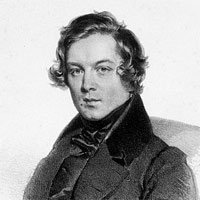Brahms's Requiem - A Beautiful Hymn to Life
The Brahms Requiem (the proper name is A German Requiem) is one of Brahms's most popular and beautiful pieces. It's a grand hymn to life.
It overturned the concept of a Requiem with a new and positive vision. Because it was a radical break with tradition and the music is exquisitely pleasant to listen to, critics called it a masterpiece.
It made Brahms famous all over Europe - his ticket to fame and recognition!
History of the Requiem

The Brahms Requiem is dedicated to Robert Schumann, Brahms's own mother, and to Humanity. Let me explain this odd mix...
Brahms probably already had had early ideas about writing a Requiem, but he was inspired to finish it by the deaths of Robert Schumann and Brahms's mother.
Schumann tried to commit suicide by drowning himself in the Rhine in 1854. Brahms was only 21 at the time, and he and Schumann shared a very special friendship based on strong appreciation of the others' musical abilities.
Schumann didn't manage to take his life, but he lived the rest of his days in an insane asylum, and died two years later. This definitely had a powerful impact on the young Brahms.
Years later in 1865, Brahms's mother died. This got the composer focusing on death again, and he started to write his Requiem.
It took Brahms three years to finish it. A preview of the first three movements went horribly wrong, since a timpani player misread the score and played his part way too loudly for several minutes, drowning out the rest of the orchestra. A shame, but hilarious nonetheless!
The first performance of the entire piece was in a cathedral on Good Friday. This time everything went well, and the piece was a massive critical success.
Brahms himself actually didn't like the title A German Requiem; he thought that "humanity" would be better.
The piece pretty much overturned the idea of the Requiem. A normal Requiem is about death, God's wrath, Judgement Day, and all sorts of other scary Christian things.
The Brahms Requiem is the exact opposite though. Brahms stitched together the text himself from parts of the Bible, and wrote it so that it comforts the living by talking about love and reincarnation. It offers hope and encouragement for humanity.
What a lovely idea! I definitely prefer Brahms's text to the gloomy traditional one.
You might also be interested in learning about Brahms's First Symphony, the epic that unequivocally established him as a master composer.
Glorious Music
The Brahms Requiem is one of the composer's biggest pieces. It needs a full orchestra, a full choir, and baritone and soprano singers. Whoa!It's in 7 movements:
- Blessed are they that mourn: Brahms left out the violins in this, so the music has a sombre feel (the violas have to make up, and they have a darker sound).
- Behold, all flesh is as the grass: a gloomy funeral march, with some lighter passages as a break from the heaviness.
- Lord, make me to know: This is where the baritone first comes in, looking for hope. The end of this movement is a energetic and complex fugue with a continuous bass note played on the timpani.
- How lovely is thy dwelling place: a peaceful and thoughtful movement. It's the exact middle of the Requiem - a kind of rest I suppose!
- Ye now are sorrowful: this movement has a beautiful soprano solo, as well as delicate orchestral writing. I find it soothing.
- Here on earth have we: Here Brahms unleashes his darkest and most powerful music.
- Blessed are the dead: The last movement is kind of a variation on the first, and ends on the same word. It's like a complete circle, an idea which mirrors what's in the text (reincarnation).
One thing people have noticed about the Brahms Requiem is that it has a very symmetrical structure. The first and last movements are very similar in mood, and the whole Requiem begins and ends on the same word: Selig (Blessed).
The second and sixth movements both have the gloomiest sound (they're also the longest sections). The third and fifth movements have the soloists contemplating hope. In the very middle is the tranquil 4th movement, which is the most popular section of the Requiem.
The piece is actually tied together by this three note motif (F-A-B), which you hear the very first time the choir starts to sing:
The magnificent music and inspirational lyrics make for a sublime listening experience (especially if you read the text at the same time).
You'd not want to spoil the requiem by listening to it with a bad audio setup. See the home audio system section for info on getting the best sound experience.
Click here to read about Brahms's music style, as well as his life story.
Recordings
My recommendation for a recording of the Brahms Requiem has to be the classic performance conducted by Otto Klemperer and played by the Philharmonia Orchestra. I love the slower, thoughtful, and extremely powerful interpretation.
The only thing bad about it is that it was recorded in 1961, which means the quality can be a bit unclear, and sometimes gets distorted during big orchestral climaxes. Still, the majesty and intelligence of the interpretation shine through!
If you like my site, please click "Like"... thanks!



